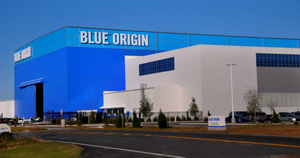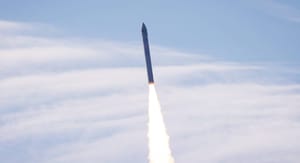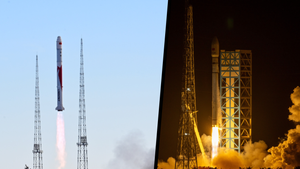
Dec 15, 2023
Bezos provides insights into Blue Origin
Recently, owner and founder of Blue Origin Jeff Bezos was a guest on the Lex Fridman Podcast, hosted by Lex Fridman. During the over two-hour podcast, Bezos made some new insights into the largely secretive Blue Origin.
This article will be broken down into three sections; Blue Ring, New Glenn, and Blue Moon. This is for easier navigation due to the amount of information.
Blue Ring

Blue Origin's Blue Ring was unveiled back on the 16th of October with claims of 'end-to-end services that span hosting, transportation, refueling, data relay, and logistics'. As well as the ability to host payloads up to 3,000 kilograms.
Bezos revealed that the 3,000 kilograms payload was for delivering payloads to either geosynchronous orbits or orbits within the 'Lunar vicinity'. Bezos did not specify what the orbits of 'Lunar vicinity' are.
It was also stated the Blue Ring could carry a single large payload or many payloads for a 'rideshare' mission. Bezos did comment that there are no plans to transport humans with Blue Ring.
For propulsion, it was commented that the spacecraft would feature both chemical and electric propulsion. The customer would choose propulsion for the spacecraft, including when to use the spacecraft's electric or chemical engines.
While unclear how the spacecraft would achieve this, Bezos also said that Blue Ring could be used to move existing spacecraft between orbits.
New Glenn

New Glenn is Blue Origin's in-development two-stage partially reusable launch vehicle currently slated for a maiden launch in 2024. New Glenn's tanks and fairings have a diameter of 7 meters, with the fairing being two carbon composite halves. New Glenn features seven BE-4 engines on the first stage, burning liquid methane and liquid oxygen, and two BE-3U engines on the second stage, burning liquid hydrogen and liquid oxygen.
It was commented by Bezos that the first launch of New Glenn in 2024 was possible with NASA's ESCAPADE mission potentially being on the first flight. Bezos also commented that liquid hydrogen is a 'great choice' for in-space stages. Current plans for re-use include landing downrange on a ship to be sent back to the cape, as said by Bezos.
In performance-related comments, Bezos said that New Glenn will be able to send up to 45,000 kilograms to low Earth orbit, with no comments on mass to geosynchronous or geosynchronous transfer orbits. It was also said that the first stage will produce 3.9 million pounds of thrust, 550 thousand pounds of thrust per engine, with the second stage producing 320 thousand pounds of thrust.
Blue Moon

Blue Moon is Blue Origin's in-development landing system that currently has two versions, Blue Moon MK1 and Blue Moon MK2. Blue Moon MK1 is designed to deliver payloads to the surface of the Moon. Blue Moon MK2 is designed for sustainable exploration of the Moon under NASA's Artemis program and plans to land astronauts on the Moon during the Artemis V mission.
Bezos commented on the Blue Moon landers' choice of fuel saying that Blue Origin is working on 'solar-powered cryo coolers' to make liquid hydrogen a storable propellant in deep space. Both landers are intended to use the company's BE-7 engine for landing.
It was also commented that Blue Moon MK1 is intended to be sent to the Moon with its cargo in one launch of the New Glenn rocket.



